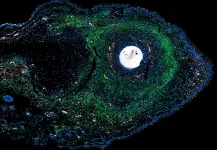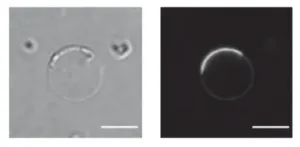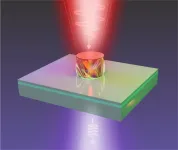(Press-News.org) CAMBRIDGE, MA -- Hormones released by the stomach, such as ghrelin, play a key role in stimulating appetite. These hormones are produced by endocrine cells that are part of the enteric nervous system, which controls hunger, nausea, and feelings of fullness.
MIT engineers have now shown that they can stimulate these endocrine cells to produce ghrelin, using an ingestible capsule that delivers an electrical current to the cells. This approach could prove useful for treating diseases that involve nausea or loss of appetite, such as cachexia (loss of body mass that can occur in patients with cancer or other chronic diseases).
In tests in animals, the researchers showed that this “electroceutical” capsule could significantly boost ghrelin production in the stomach. They believe this approach could also be adapted to deliver electrical stimulation to other parts of the GI tract.
“This study helps establish electrical stimulation by ingestible electroceuticals as a mode of triggering hormone release via the GI tract,” says Giovanni Traverso, an associate professor of mechanical engineering at MIT, a gastroenterologist at Brigham and Women’s Hospital, and the senior author of the study. “We show one example of how we're able to engage with the stomach mucosa and release hormones, and we anticipate that this could be used in other sites in the GI tract that we haven’t explored here.”
Khalil Ramadi SM ’16, PhD ’19, a graduate of the Department of Mechanical Engineering and the Harvard-MIT Program in Health Sciences and Technology, who is now an assistant professor of bioengineering at the NYU Tandon School of Engineering and Director of the Laboratory for Advanced Neuroengineering and Translational Medicine at NYU Abu Dhabi, and James McRae, an MIT graduate student, are the lead authors of the paper, which appears today in Science Robotics.
Electrical stimulation
The enteric nervous system controls all aspects of digestion, including the movement of food through the GI tract. Some patients with gastroparesis, a disorder of the stomach nerves that leads to very slow movement of food, have shown symptomatic improvement after electrical stimulation generated by a pacemaker-like device that can be surgically implanted in the stomach.
Doctors had theorized that the electrical stimulation would provoke the stomach into contracting, which would help push food along. However, it was later found that while the treatment does help patients feel better, it affected motility to a lesser degree. The MIT team hypothesized that the electrical stimulation of the stomach might be leading to the release of ghrelin, which is known to promote hunger and reduce feelings of nausea.
To test that hypothesis, the researchers used an electrical probe to deliver electrical stimulation in the stomachs of animals. They found that after 20 minutes of stimulation, ghrelin levels in the bloodstream were considerably elevated. They also found that electrical stimulation did not lead to any significant inflammation or other adverse effects.
Once they established that electrical stimulation was provoking ghrelin release, the researchers set out to see if they could achieve the same thing using a device that could be swallowed and temporarily reside in the stomach. One of the main challenges in designing such a device is ensuring that the electrodes on the capsule can contact the stomach tissue, which are coated with fluid.
To create a drier surface that electrodes can interact with, the researchers gave their capsule a grooved surface that wicks fluid away from the electrodes. The surface they designed is inspired by the skin of the Australian thorny devil lizard, which uses ridged scales to collect water. When the lizard touches water with any part of its skin, water is transported by capillary action along the channels to the lizard’s mouth.
“We were inspired by that to incorporate surface textures and patterns onto the outside of this capsule,” McRae says. “That surface can manage the fluid that could potentially prevent the electrodes from touching the tissue in the stomach, so it can reliably deliver electrical stimulation.”
The capsule surface consists of grooves with a hydrophilic coating. These grooves function as channels that draw fluid away from the stomach tissue. Inside the device are battery-powered electronics that produce an electric current that flows across electrodes on the surface of the capsule. In the prototype used in this study, the current runs constantly, but future versions could be designed so that the current can be wirelessly turned on and off, according to the researchers.
Hormone boost
The researchers tested their capsule by administering it into the stomachs of large animals, and they found that the capsule produced a substantial spike in ghrelin levels in the bloodstream.
“As far as we know, this is the first example of using electrical stimuli through an ingestible device to increase endogenous levels of hormones in the body, like ghrelin. And so, it has this effect of utilizing the body's own systems rather than introducing external agents,” Ramadi says.
The researchers found that in order for this stimulation to work, the vagus nerve, which controls digestion, must be intact. They theorize that the electrical pulses transmit to the brain via the vagus nerve, which then stimulates endocrine cells in the stomach to produce ghrelin.
Traverso’s lab now plans to explore using this approach in other parts of the GI tract, and the researchers hope to test the device in human patients within the next three years. If developed for use in human patients, this type of treatment could potentially replace or complement some of the existing drugs used to prevent nausea and stimulate appetite in people with cachexia or anorexia, the researchers say.
“It's a relatively simple device, so we believe it's something that we can get into humans on a relatively quick time scale,” Traverso says.
###
The research was funded by the Koch Institute Support (core) Grant from the National Cancer Institute, the National Institute for Diabetes and Digestive and Kidney Diseases, the Division of Engineering at New York University Abu Dhabi, a National Science Foundation graduate research fellowship, Novo Nordisk, and the Department of Mechanical Engineering at MIT.
END
Ingestible “electroceutical” capsule stimulates hunger-regulating hormone
The device, which uses electricity to boost hormone production in the stomach, could help to ease nausea and counteract appetite loss
2023-04-26
ELSE PRESS RELEASES FROM THIS DATE:
Musical expertise makes older adults better listeners by keeping brain young
2023-04-26
The world’s population is aging at an unprecedented rate. Aging can lead to various types of cognitive decline, posing a serious burden to families and society. Therefore, it is crucial to develop effective interventions to promote healthy aging.
One promising approach is musical training, which is accessible to the majority of the population. Besides the musically rewarding and aesthetic experience of musical training, it also provides potential benefits to the brain, especially for the elderly.
In a study published as a cover story in Science Advances, a research team led by Dr. DU Yi from the Institute ...
ERK activity is a molecular switch between tissue regeneration and scarring
2023-04-26
Why do some animals regenerate lost tissues after injury while others don’t? Researchers from the lab of Kerstin Bartscherer (Osnabrück University and formerly Hubrecht Institute) and Ashley Seifert (University of Kentucky) studied spiny mice, which have a remarkable regenerative capacity, to answer this question. They compared and modulated the injury responses of these mice and common laboratory mice, that show scarring upon injury. This revealed that ERK signalling is a crucial molecular switch between scarring and regeneration. The results of this study will be published on April 26th in the scientific journal Science Advances and imply that ...
Decoding the mechanisms behind the assembly of BAR proteins that dictate cell curvature
2023-04-26
Ikoma, Japan – Cell membranes play a critical role by serving as containment units and separating the inner cellular space from the extracellular environment. Proteins with distinct functional units play a key role in facilitating protein-membrane interactions. For instance, “Bin-Amphiphysin-Rvs” (“BAR”) domain proteins are involved in regulating cell membrane curvature. This physical bending of cell membranes helps cells carry out various biologically important processes such as endocytosis and cell motility. Although BAR proteins drive membrane curvature ...
Children’s Hospital of Philadelphia, Princeton researchers identify novel genetic disorder
2023-04-26
Philadelphia, April 26, 2023 – Researchers from Children’s Hospital of Philadelphia (CHOP) and Princeton University have discovered a novel genetic disorder associated with neurodevelopmental differences. The discovery identified the disorder in 21 families from all over the world. The findings were published today in Science Advances.
The as-yet unnamed disorder is the result of a series of rare variants in the MAP4K4 gene, which is involved in many signaling pathways, including the RAS pathway ...
Almost one in three adults aged 45 and older who had both TB and COVID-19 died during a pandemic cohort study in NYC between March 2020 and June 2022
2023-04-26
Almost one in three adults aged 45 and older who had both TB and COVID-19 died during a pandemic cohort study in NYC between March 2020 and June 2022.
####
Article URL: https://journals.plos.org/globalpublichealth/article?id=10.1371/journal.pgph.0001758
Article Title: Cohort study of the mortality among patients in New York City with tuberculosis and COVID-19, March 2020 to June 2022
Author Countries: USA
Funding: The authors received no specific funding for this work. END ...
Nifty nanoparticles help ‘peel back the curtain’ into the world of super small things
2023-04-26
Physicists at The Australian National University (ANU) are using nanoparticles to develop new sources of light that will allow us to “peel back the curtain” into the world of extremely small objects – thousands of times smaller than a human hair – with major gains for medical and other technologies.
The findings, published in Science Advances, could have major implications for medical science by offering an affordable and effective solution to analyse tiny objects that are too small for microscopes to see, let alone the human eye. The work could also be beneficial for the semiconductor industry ...
Tree diversity increases carbon storage, soil fertility in forests
2023-04-26
Keeping tree diversity intact in Canada’s many forests over the long term can help increase carbon capture and mitigate climate change, according to a new University of Alberta study.
The study, published in Nature, is the first of its kind to show the sustained benefits of tree diversity on a large spatial scale, in terms of storing carbon and nitrogen in the soil. It reinforces the importance of biodiversity conservation in forests, says Xinli Chen, lead author on the paper and postdoctoral fellow in the Faculty of Agricultural, ...
New findings indicate gene-edited rice might survive in Martian soil
2023-04-26
Andy Weir’s bestselling 2011 book, The Martian, features botanist Mark Watney’s efforts to grow food on Mars after he becomes stranded there. While Watney’s initial efforts focus on growing potatoes, new research presented at the 54th Lunar and Planetary Science Conference by a team of interdisciplinary researchers from the U of A suggests future Martian botanists like Watney may have a better option: growing rice.
As outlined in the team’s abstract, Rice Can Grow and Survive in Martian ...
New research sheds light on how circadian rhythms work
2023-04-26
ITHACA, N.Y. -- New research from a multidisciplinary team helps to illuminate the mechanisms behind circadian rhythms, offering new hope for dealing with jet lag, insomnia and other sleep disorders.
Using innovative cryo-electron microscopy techniques, the researchers have identified the structure of the circadian rhythm photosensor and its target in fruit flies (Drosophila melanogaster), one of the major organisms used to study circadian rhythms. The research, “Cryptochrome-Timeless Structure Reveals Circadian Clock Timing ...
Brain aging expert Ashley Webb, Ph.D. joins faculty at Buck Institute for Research on Aging
2023-04-26
The Buck Institute for Research on Aging announces that Ashley Webb, PhD, will join its faculty as an associate professor on August 1, 2023. Webb’s research is focused on the molecular mechanisms underlying stem cells and brain aging. She joins the Buck from Brown University, where she is currently an associate professor in the Department of Molecular Biology, Cell Biology and Biochemistry. Webb uses a combination of mouse models, cell culture approaches and genomics technologies to investigate the epigenetic and transcriptional mechanisms that preserve healthy ...
LAST 30 PRESS RELEASES:
First Editorial of 2026: Resisting AI slop
Joint ground- and space-based observations reveal Saturn-mass rogue planet
Inheritable genetic variant offers protection against blood cancer risk and progression
Pigs settled Pacific islands alongside early human voyagers
A Coral reef’s daily pulse reshapes microbes in surrounding waters
EAST Tokamak experiments exceed plasma density limit, offering new approach to fusion ignition
Groundbreaking discovery reveals Africa’s oldest cremation pyre and complex ritual practices
First breathing ‘lung-on-chip’ developed using genetically identical cells
How people moved pigs across the Pacific
Interaction of climate change and human activity and its impact on plant diversity in Qinghai-Tibet plateau
From addressing uncertainty to national strategy: an interpretation of Professor Lim Siong Guan’s views
Clinical trials on AI language model use in digestive healthcare
Scientists improve robotic visual–inertial trajectory localization accuracy using cross-modal interaction and selection techniques
Correlation between cancer cachexia and immune-related adverse events in HCC
Human adipose tissue: a new source for functional organoids
Metro lines double as freight highways during off-peak hours, Beijing study shows
Biomedical functions and applications of nanomaterials in tumor diagnosis and treatment: perspectives from ophthalmic oncology
3D imaging unveils how passivation improves perovskite solar cell performance
Enriching framework Al sites in 8-membered rings of Cu-SSZ-39 zeolite to enhance low-temperature ammonia selective catalytic reduction performance
AI-powered RNA drug development: a new frontier in therapeutics
Decoupling the HOR enhancement on PtRu: Dynamically matching interfacial water to reaction coordinates
Sulfur isn’t poisonous when it synergistically acts with phosphine in olefins hydroformylation
URI researchers uncover molecular mechanisms behind speciation in corals
Chitin based carbon aerogel offers a cleaner way to store thermal energy
Tracing hidden sources of nitrate pollution in rapidly changing rural urban landscapes
Viruses on plastic pollution may quietly accelerate the spread of antibiotic resistance
Three UH Rainbow Babies & Children’s faculty elected to prestigious American Pediatric Society
Tunnel resilience models unveiled to aid post-earthquake recovery
Satellite communication systems: the future of 5G/6G connectivity
Space computing power networks: a new frontier for satellite technologies
[Press-News.org] Ingestible “electroceutical” capsule stimulates hunger-regulating hormoneThe device, which uses electricity to boost hormone production in the stomach, could help to ease nausea and counteract appetite loss





